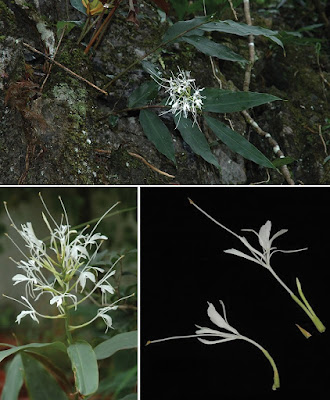[Most Recent Entries] [Calendar View]
Saturday, November 3rd, 2018
| Time | Event | ||||
| 2:06p | [Herpetology • 2018] Multiple Connections between Amazonia and Atlantic Forest shaped the Phylogenetic and Morphological Diversity of Chiasmocleis Mehely, 1904 (Microhylidae: Gastrophryninae)
Highlights: • Comprehensive phylogeny of the most species-rich genus of Neotropical microhylids. • Species discovery analysis suggests a high number of cryptic species. • Small-sized species evolved independently three times in the clade and miniaturized species form a clade restricted to Amazonia. • Miniaturization results in loss of digits, phalanges, and pectoral girdle elements. • Biogeography of Chiasmocleis was shaped by multiple connections between Amazonia and Atlantic Forest. Abstract Chiasmocleis is the most species-rich genus of Neotropical microhylids. Herein, we provide the first comprehensive multilocus phylogeny for the genus, including all but 3 of the 34 recognized species and multiple individuals per species. We discuss cryptic speciation, species discovery, patterns of morphological evolution, and provide a historical biogeographic analysis to account for the current distribution of the genus. Diversification of Chiasmocleis from other New World microhylids began during the Eocene, app. 40 mya, in forested areas, and current diversity seems to be a product of recurrent connections between the Atlantic Forest and Amazonia. Small-sized species evolved independently three times in Chiasmocleis. Furthermore, the extremely small-bodied (i.e. miniaturized) species with associated loss of digits, phalanges, and pectoral girdle cartilages evolved only once and are restricted to Amazonia. Using the phylogeny, we recognized three subgenera within Chiasmocleis: Chiasmocleis Méhely, 1904, Relictus subg. nov., and Syncope Walker, 1973. The recognition of the subgenus Syncope informs future research on patterns of miniaturization in the genus, and the subgenus Relictus highlights isolation of an endemic and species-poor lineage to the Atlantic Forest, early (about 40 mya) in the history of Chiasmocleis. Keywords: Phylogeny, Chiasmocleis, Species discovery, Morphology, Miniaturization, Biogeography
Rafael O. de Sá, João Filipe Riva Tonini, Hannahvan Huss, Alex Long, Travis Cuddy, Mauricio C. Forlani, Pedro L.V. Peloso, Hussam Zaher and Célio F.B. Haddad. 2018. Multiple Connections between Amazonia and Atlantic Forest shaped the Phylogenetic and Morphological Diversity of Chiasmocleis Mehely, 1904 (Anura: Microhylidae: Gastrophryninae). Molecular Phylogenetics and Evolution. 130; 198-210. DOI: 10.1016/j.ympev.2018.10.021 | ||||
| 2:30p | [Botany • 2018] Hedychium viridibracteatum (Zingiberaceae) • A New Species from Guangxi Autonomous Region, South China
Abstract Hedychium viridibracteatum X.Hu, a new species from Guangxi Zhuang Autonomous Region, South China, is described and illustrated. Hedychium viridibracteatum X.Hu is included in the short-anther group of Hedychium and is most similar to Hedychium villosum Wall. var. tenuiflorum Voigt ex Baker, H. villosum Wall. var. villosum Wall., and H. chingmeianum N. Odyuo & D. K. Roy. Keywords: Hedychium, Zingiberaceae, new species, Guangxi Autonomous Region Hedychium viridibracteatum X.Hu, sp. nov. Diagnosis: Hedychium viridibracteatum X.Hu, sp. nov. is morphologically similar to H. villosum Wall. var. tenuiflorum Voigt ex Baker by having sagittate anther, long filament, relatively thick and small leaves, more than two flower per-bract, but can be easily distinguished from it by its green (vs. brown) shorter bracts (1.3–1.5 × 0.4–0.5 cm vs. 2.7–2.9 × 1.1–1.2 cm) and bracteoles (1.0–1.1 × 0.3–0.4 cm vs. 2.1–2.2 × 0.7–0.75 cm), pure white flowers (vs. white with red stamen), dentate (vs. acute) tips to the lateral staminodes, and the apex of the labellum incised to the middle (vs. deeply divided). .... Etymology: The new species is named after its green bracts and pure white flowers which are highly diagnostic. Habitat: This species is currently found on limestone rocks in Guangxi Autonomous Region (Napo, Longzhou and Jingxi Counties) mainly growing under forest at altitudes of 600–800 m. Xiu Hu, Jia-qi Huang, Jia-chuan Tan, Yong-qing Wu and Juan Chen. 2018. Hedychium viridibracteatum X.Hu, A New Species from Guangxi Autonomous Region, South China. PhytoKeys. 110: 69-79. DOI: 10.3897/phytokeys.110.28710 |
| << Previous Day |
2018/11/03 [Calendar] |
Next Day >> |











